English Heritage.
This deserted medieval village comprises four thirteenth century stone farmsteads, which were probably abandoned in the 15th century. Walls survive to a height of about 3 feet, marking out the outline of various structures.
This is quite an interesting site to find and visit. You will need a detailed local map. If you park by the minor road that runs to the west, the village is more or less behind Hound Tor, so you have to climb the Tor or skirt around it till you see the remains. Distance about 1000 yards. Walking boots and stout trousers are recommended, as there may be dense vegetation in places.
Category: Ruin
ruins of all kinds
Haytor Granite Tramway, Dartmoor, Devon
In the 1820’s a tramway with granite stone rails was constructed from granite quarries around Haytor to a canal terminal near Bovey Tracey. The tramway was required to get the granite down a steep gradient from the quarries on the moor to a location where it could be loaded onto water-bourne transport. The tramway was in use for several decades, and sections of the branching tracks can still be seen on the moors around the old workings, and crossing modern roads.
It’s interesting to follow these on the ground, and it also makes for a healthy walk. To get started, you need a large scale map that shows the tramways in relation to the modern roads and the Tor. Boots and stout trousers may be required in the more rubble-strewn or overgrown spots. My sister lives in Devon so I just borrowed her maps…
Burgh Castle, Norfolk
English Heritage.
This is a Roman “Saxon Shore” fort in countryside near Yarmouth, and close to the River Waveney. Three walls and various towers stand to near their original height, the fourth wall having collapsed into the river centuries ago.
Both the size of the site and the degree of preservation of the wall and towers are quite impressive. It’s worth seeking it out if you are in the area. There is no charge for visiting. Visitors should find somewhere to park near the church, and follow the signed footpath.
Grimspound, Devon
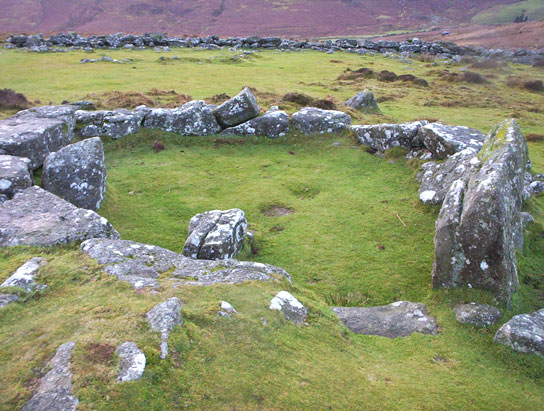
Grimspound is a late Bronze Age settlement on Dartmoor, Devon. It consists of a set of 24 hut circles surrounded by a low stone wall. It was probably first settled around 1300BC. Each of the roundhouses had a massive perimeter wall built of granite.
Today, the ring wall that enclosed the settlement can be clearly seen, and many of the hut circles are clearly identifiable. The surrounding country is desolate, with few signs of human habitation.
This is an inspiring place to visit, as one rarely has the opportunity to stand in the ruins of anything so old but still identifiable as housing. It can also be rather difficult to find, as there is little signage and there are few obvious landmarks on the nearby roads.
If you have the kind of sat-nav that lets you enter the OS ref or lat/long directly, that no doubt would be a great help. Otherwise, drive west along the B3212 from Moretonhampstead for about 8 miles, passing the Minature Pony Centre and ascending a hill. The road sweeps right, then left, and about 2 miles past the Minature Pony Centre there is a tarmac turning to the left, showing as a 40 deg. fork on the satellite view. (& possibly signed for Dunstone or Widdecombe). At about 1.2 miles look out for a dip and kink in the road with stopping place and an inconspicuous sign immediately preceding. Grimspound is about 400 yards above here to the left. (The surrounding wall shows faintly on the satellite view as a circle.)
If you see a track on the right joining from below, you are passing the place where you should stop…
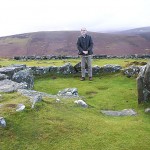
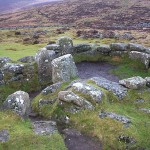
Cadbury Castle, Devon
This Iron Age hill fort site is near Furzdon House (see separate entry) and the village of Cadbury.
I would have liked to walk up to it, but on my first visit to the area it was not obvious where the preferred access was. There is a signed footpath starting from the village lane, about half a mile down from the A3072. Also, the satellite view shows what looks like a farm vehicle track running from a field on the A3072 up to the top, which is marked by a circle of trees.
The second time around, my sister didn’t care to walk up it in the hot sun:-)
Fotheringay Castle, Northants.
This castle, with its Mary Queen of Scots asociations, is probably the most romantic castle site in England,and a magnet for visitors. Too bad that it doesn’t exist any more; you can visit the castle mound, but all that visibly remains of the great castle is a tumbled chunk of masonry at the foot of the mound that might have come from its walls.
As a consolation prize, the village has many attractive buildings in honey coloured stone, and the great 15th Century Collegiate Church should be worth a visit. (I didn’t see it when I visited the “castle” as I knew nothing about it.)
Kirby Hall, Northants.
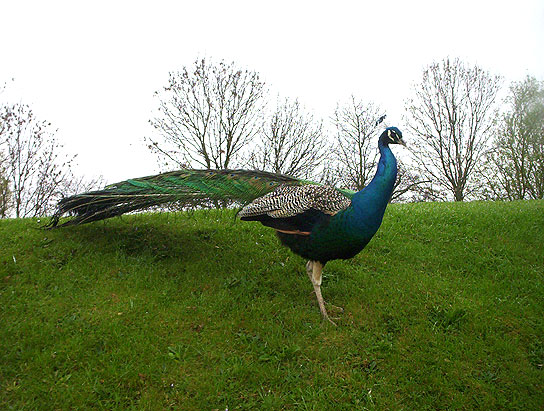
This is a great Elizabethan and 17th-century house, now partly roofless, though the Great Hall and state rooms are still roofed and intact. These rooms are refitted and redecorated to 17th and 18th century specifications. There is an outer walled courtyard, while buildings, some now roofless, surround the inner courtyard. The entry to the inner courtyard has an impressive three-tier porch.
The bulk of the building, with its elaborate stonework, and many tall chimneys, remains impressive. The state rooms have a pair of large and distinctive curving bay windows. Inside, the interiors and exhibitions are of interest. Outside is a great 17th-century garden, recently recreated. Peacocks roam in the grounds. An audio tour is available.
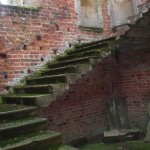
Brougham Castle, Cumbria
English Heritage.
Brougham Castle , built of reddish stone in a picturesque setting beside the crossing of the River Eamont in Cumbria, was founded in the early 13th century. This great keep largely survives, amid many later buildings – including the unusual double gatehouse and impressive ‘Tower of League’. The castle was both a formidable barrier against Scots invaders and a prestigious residence, and welcomed Edward I in 1300.
Much of the structures survive, with the dressed stone cladding largely intact. A complex of passages and spiral stairways makes Brougham a fascinating castle to explore, as well as an ideal picnic setting for a family day out. The keep top provides panoramic views over the Eden Valley. The relatively complete state of the structures, and the attractive green settng, make this a worthwhile and pleasant place to visit. There is an exhibition about Lady Ann Clifford.
Opened daily. Admission charge. The castle shares a guidebook with Brough Castle, a few miles away. Access is from Moor Lane.
Brough Castle, Cumbria
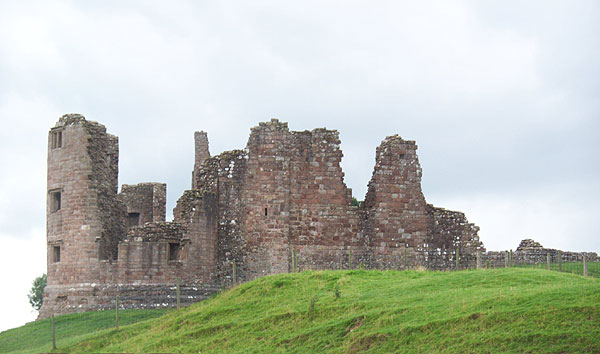 English Heritage.
English Heritage.
Brough Castle stands on a ridge commanding strategic Stainmore Pass, on the site of a Roman fort. Its towering keep, frequently the target of Scots raids, dates from about 1200. More comfortable living quarters were later added by the Clifford family, only to be accidentally burnt following a ‘great Christmas party’ in 1521. Like so many other castles hereabouts, Brough was restored in the 17th century by the Lady Anne Clifford, traces of whose additions can still be seen.
St Michael’s Parish Church, in pretty Church Brough near the castle, displays an exhibition about the region.
The castle is much ruined, though the keep stands to some height. Inside the curtain walls there are various structures to look at.
Opened daily, no admission charge. The castle shares a guidebook with Broughton Castle, a few miles away.
Totnes Castle, Devon
English Heritage.
This was a classic Norman motte and bailey castle, founded soon after the Conquest to overawe the Saxon town. A later stone shell-keep crowns its steep mound, and gives sweeping views across the town rooftops to the River Dart. The shell-keep wall is in a fair state of preservation, as can be seen in stock photos.
Apart from the view, there’s not a large amount of things to look at, but the circular shell keep itself looks rather iconic. You’d think that a castle on a high mound would be easy to spot, but if I remember correctly I had a lot of difficulty finding it, because the crowded old buildings block any view of it from street level. If you don’t have any luck with brown signs, find a good street map and track it down with that. The old centre of Totnes is not car-friendly so if you arrive by car it would be best to park it in a car park on the edge of the town centre and continue on foot. When I was last there, it was possible to drive up the length of the old high street and under the building that spans the street, but I really wouldn’t recommend it! Also, the exit from the top of the high street onto the ring road is hazardous, because of poor visibility and high-speed idiots.
Other EH castles are in the same area of South Devon.
